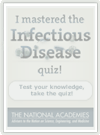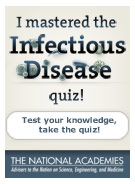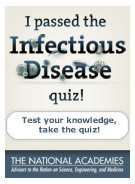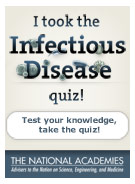
What You Need To Know About Infectious Disease
What do you know about infectious disease?
True or False: Not all microbes are harmful to humans.
-
Correct!
Not all microbes are harmful to humans. In fact, many of them protect us, helping our bodies function properly and competing with harmful organisms in an eternal contest for habitable space in or on our bodies. Although the microorganisms that cause disease often receive more attention, most microorganisms do not cause illness.
-
Sorry, that’s incorrect.
Not all microbes are harmful to humans. In fact, many of them protect us, helping our bodies function properly and competing with harmful organisms in an eternal contest for habitable space in or on our bodies. Although the microorganisms that cause disease often receive more attention, most microorganisms do not cause illness.
Which of the following is NOT a vector-borne disease?
-
Correct!
Influenza is not a vector-borne disease, meaning it is not transmitted to humans indirectly via an insect, an arthropod, or another animal. Malaria and yellow fever are transmitted by mosquitoes. Lyme disease is transmitted by deer ticks.
-
Sorry, that’s incorrect.
Influenza is not a vector-borne disease, meaning it is not transmitted to humans indirectly via an insect, an arthropod, or another animal. Malaria and yellow fever are transmitted by mosquitoes. Lyme disease is transmitted by deer ticks.
-
Sorry, that’s incorrect.
Influenza is not a vector-borne disease, meaning it is not transmitted to humans indirectly via an insect, an arthropod, or another animal. Malaria and yellow fever are transmitted by mosquitoes. Lyme disease is transmitted by deer ticks.
-
Sorry, that’s incorrect.
Influenza is not a vector-borne disease, meaning it is not transmitted to humans indirectly via an insect, an arthropod, or another animal. Malaria and yellow fever are transmitted by mosquitoes. Lyme disease is transmitted by deer ticks.
The human papillomavirus (HPV) causes about what percentage of cervical cancer cases?
-
Sorry, that’s incorrect.
The human papillomavirus (HPV) causes more than 90% of cervical cancer cases.
-
Sorry, that’s incorrect.
The human papillomavirus (HPV) causes more than 90% of cervical cancer cases.
-
Correct!
The human papillomavirus (HPV) causes more than 90% of cervical cancer cases.
True or False: Major pharmaceutical companies have great interest in dedicating resources to the antibiotics market because these short-course drugs are more profitable than drugs that treat chronic conditions and lifestyle ailments, such as high blood pressure or high cholesterol.
-
Sorry, that’s incorrect.
Drugs that treat chronic conditions and lifestyle ailments are more profitable. Modern medicine needs new kinds of antibiotics to treat drug-resistant infections, but antibiotic research and development are expensive, risky, and time-consuming.
-
Correct!
Drugs that treat chronic conditions and lifestyle ailments are more profitable. Modern medicine needs new kinds of antibiotics to treat drug-resistant infections, but antibiotic research and development are expensive, risky, and time-consuming.
Which of these viral diseases has the most antiviral drugs available to treat it?
-
Sorry, that’s incorrect.
Today there are more antiviral drugs available for HIV than for any other viral disease, transforming an infection that was once considered a death sentence into a manageable chronic condition.
-
Correct!
Today there are more antiviral drugs available for HIV than for any other viral disease, transforming an infection that was once considered a death sentence into a manageable chronic condition.
-
Sorry, that’s incorrect.
Today there are more antiviral drugs available for HIV than for any other viral disease, transforming an infection that was once considered a death sentence into a manageable chronic condition.
-
Sorry, that’s incorrect.
Today there are more antiviral drugs available for HIV than for any other viral disease, transforming an infection that was once considered a death sentence into a manageable chronic condition.
Which of the following is not a viral disease:
-
Sorry, that’s incorrect.
Trichinosis is not a viral disease. It is caused by a helminth (parasitic worm) found in undercooked meat, not by a virus.
-
Sorry, that’s incorrect.
Trichinosis is not a viral disease. It is caused by a helminth (parasitic worm) found in undercooked meat, not by a virus.
-
Correct!
Trichinosis is not a viral disease. It is caused by a helminth (parasitic worm) found in undercooked meat, not by a virus.
True or False: Scientists believe that hot weather may speed up both the breeding cycle of mosquitoes and replication of the virus in insects’ guts.
-
Correct!
Scientists believe that hot weather may speed up both the breeding cycle of mosquitoes and replication of the virus in insects’ guts.
-
Sorry, that’s incorrect.
Scientists believe that hot weather may speed up both the breeding cycle of mosquitoes and replication of the virus in insects’ guts.
True or False: Antibiotics work by introducing an agent that resembles a disease-causing microbe, thus stimulating the body's immune system to recognize it as foreign, destroy it, and "remember" it, so that it can more easily identify and destroy any similar, disease-causing microbes that it later encounters.
-
Sorry, that’s incorrect.
The above describes how vaccines work. Antibiotics work by either killing bacteria or stopping them from reproducing, allowing the body's natural defenses to eliminate the pathogens.
-
Correct!
The above describes how vaccines work. Antibiotics work by either killing bacteria or stopping them from reproducing, allowing the body's natural defenses to eliminate the pathogens.
Which of the following is needed to help improve the public health situation in developing countries?
- More safe water supplies
- Better sewage treatment and disposal
- Improved food safety and vaccination programs
- All of the above
-
Sorry, that’s incorrect.
All of the above are urgently needed in developing nations. A major barrier to achieving these improvements is the underlying weakness of health systems in resource-poor countries, including a shortage of health workers and a lack of disease surveillance programs.
-
Sorry, that’s incorrect.
All of the above are urgently needed in developing nations. A major barrier to achieving these improvements is the underlying weakness of health systems in resource-poor countries, including a shortage of health workers and a lack of disease surveillance programs.
-
Sorry, that’s incorrect.
All of the above are urgently needed in developing nations. A major barrier to achieving these improvements is the underlying weakness of health systems in resource-poor countries, including a shortage of health workers and a lack of disease surveillance programs.
-
Correct!
All of the above are urgently needed in developing nations. A major barrier to achieving these improvements is the underlying weakness of health systems in resource-poor countries, including a shortage of health workers and a lack of disease surveillance programs.
Thank you for taking our quiz.
Place this badge on your Facebook page to show your friends what you know about infectious disease.
Place this badge on your Facebook page to show your friends what you know about infectious disease.
OR, get a higher score to unlock a different badge.

Place this badge on your Facebook page to show your friends what you know about infectious disease.
OR, get a higher score to unlock a different badge.

Explore Other Topics
Disease Watchlist
Infectious Disease Defined
- Pandemic
An increase in the occurrence of a particular disease over a very large region, such as a continent or the entire globe, that is greater than what is expected over a given period of time.


